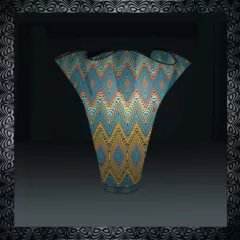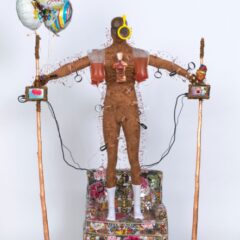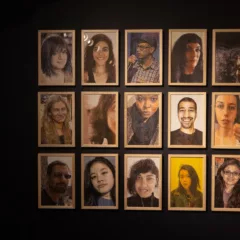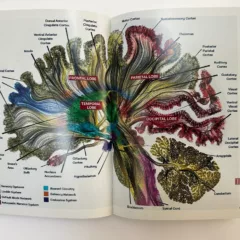Does “artificial intelligence” actually exist? All forms of generative artificial intelligence (AI) being used to make artworks necessitate human input, programming, and activation. “The original question, ‘Can machines think?’, I believe to be too meaningless to deserve discussion” states Alan Turing, reasoning that instead of the possibility of intelligent independent thought being tested, it is more relevant to test the capacity of machines to imitate human answers to questions. Now with generative AI, human language and image-making can be closely imitated. It was previously thought that only other humans could document the experience of living on earth, through written or visual art – to capture the soul through expression.
Is it possible to define any intelligence beyond our human-centric or culturally biased understanding? Objects have always learned from us. The axe may learn how the owner grasps it over time, wearing away to form to that particular hand – is that intelligence? Could there be intelligence held by things that are unable or uninterested to carry on a conversation with us?
Object-oriented ontology (OOO) puts objects at the center of the study of existence. It proposes that “things” are no different from living beings – that all are objects existing equally. That objects have desires, needs, and wants. OOO rejects “correlationism”, defined as the human instinct to think of things only in the ways that they affect us.
“Art is …pouring out of anything whatsoever, whether we humans consider it to be alive or sentient or not.” Timothy Morton explains how art objects act on their viewers, a power that all objects possess. In the realm of OOO, objects have hidden agency that is beyond the field of our comprehension. Does a generative AI program – an object for purposes of this discussion – desire to replace all human artists? Seems like a rather human-centric correlational thought.
Why are we so afraid of our own creation?
We fear the consciousness of what we have birthed – the free will of Adam, of Frankenstein’s Monster, of Golems, of Galatea. We fear the desire towards our creation and that we will come to our end. Humanity yearns for what is greater than ourselves, surrender, God, loss of control. We crave to be overtaken. Perhaps in the thrust of a society so fixated on its demise – we fantasize that we have created a singular tool to destroy us. We forget that machines have no agenda except to do what we have designed and programmed them to do. Like most fears this one originates inwardly, what we are truly afraid of is ourselves and other humans.
Until recent years, the popular fear was that physical jobs would become automated. Self-driving delivery trucks, robot farmers, and AI garment makers (A lot of these things do exist but face continual problems in scaling, being popularized, and fully eradicating the human element… for now.). Working-class jobs were at risk, but the creative jobs centered around ideation, writing, and image-making were surely untouchable. It turns out it is actually quite difficult to build and maintain machines that independently cut and sew a tee shirt, and quite simple to produce images and language through AI. Our idea that manual labor is simpler to automate is based on social hierarchies, and tradition, not based on the status of technology.
In the 1960’s the popular vision of a world with automation and assistance through technology was to imagine a world in which work was easy, or didn’t exist at all. In the cartoon sitcom The Jetsons (1962), George Jetson had a 1 hour work day, 2 days out of the week.
“We are less than a lifetime from achieving Gene Roddenbery-style Fully Automated Luxury Gay Space Communism, but only at the expense of the Billionaire legacy overlords, says artist and AI user, Natalie Hijinx. “I don’t think they’ll let us even dream of having that without a real fight. That is what is at stake here.”
Presently we are surrounded by automated devices that simply require us to work more. Celeste Rodero, another artist who disagrees with the current and potential usage of AI states that AI “ may have new consequences, but it’s enmeshed with oppression, therefore it’s not a new problem, it’s part of the problems we are already facing and dying from.”
The conversation around AI often obscures the actual human artistic labor that goes on behind it, Hijinx says. “There is still a lot of technical skill, art direction, creative vision, and time investment necessary to achieve the kind of final work desired.” Science fiction writer and artist Alex Smith speaks on the racist bias of generative AI, “If you see any AI art that features beautiful Black people in interesting, empowering settings– especially fat Black people– then just know that person probably spent hours trying to get the image to work.”
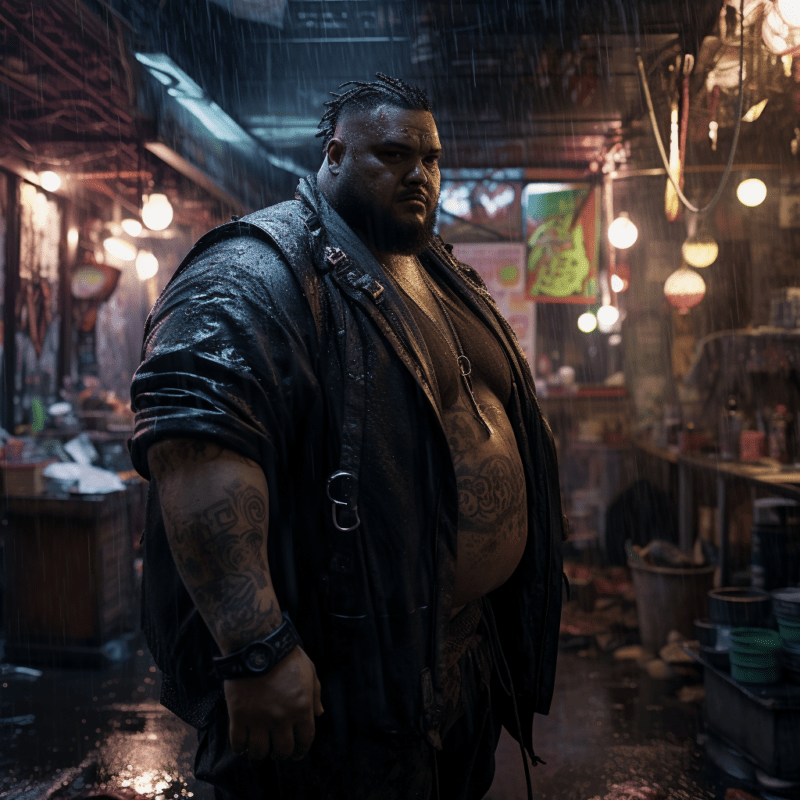
Almost 75 years ago, Geoffery Jefferson backs them up, “Nor must we overlook the limitations of the machines. They need very intelligent staffs to feed them with the right problems, and they will attempt the insoluble and continue at it until the current is switched off. Their great advantage is their speed compared with a human mind…But, it may be asked, is that so very much more marvelous than the crane that can lift so much more than can a man or than an automobile that can move so much quicker?”
In the many years that have passed since 1949 – Jefferson’s cautionary words remain true and an interesting rebuttal. So, generative AI can create art faster than the human body – is that so very much more marvelous? It is simply executing what it is designed to do.
Benefits include accessibility
The readymade, a mass-produced object elevated to the status of art through the choice of the artist, follows a similar conceit. The readymade was not birthed ready or made but was indeed made by a people. Several people designed and executed the object, packaging it, placing it on the shelves, and sometimes delivering it to your door. The artist Carolyn Lazard frames the use of readymade as a measure of accessibility – enabling disabled artists to create and even install artwork from behind a laptop in bed. That is, the use of generative AI in art opens up what is possible beyond ability. Artists who don’t have the physical ability, training, or resources to create the things they imagine can use generative AI as a tool to make those ideas visually manifest.
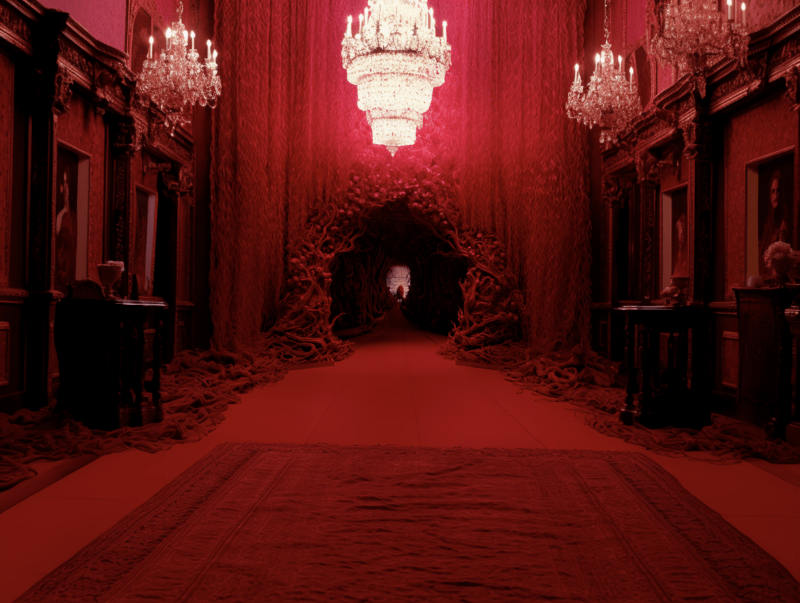
“There are so many unknown possibilities and applications. I specifically love this about the technology. The wide open horizon.” Hijinx says, explaining that there are so many projects that she’s never had the resources to fund and execute, that over the next few years will finally become possible. Smith is excited about the amount of access generative AI gives to marginalized creators, “Hundreds of marginalized people have been creating some very interesting things, looking outside of the limiting parameters of typical illustration.”
Figuration, selfies, deep fakes and the attention economy
One of the marks of “successful” AI is if it can replicate images of humans, and depending on the skill of the prompt maker, that kind of success is possible. The past few years have shown a rising trend in figuration in art – in no small part due to the legibility of representational images on the small handheld screen. The social media algorithm gives preferential treatment to figurative images (selfies). In an attention economy where artists must self-exploit to survive – the face always wins out. However, in a landscape of millions of bots and deep fakes, representational images made with AI are in competition for this attention. Does it matter which face is real?
Figuration can also be used as a way of expressing subjectivity and representing marginalized people who have been historically underrepresented in visual art. Smith relishes in the ability to create beautiful images of queer, Black, fat gay men in fantasy and science fiction settings. He
also makes some more everyday imagery “big chubby gay dudes at poetry readings, on dates… at punk shows in record stores– because there are access issues within these real-world spaces that are often denied queer people of size as well.”

Like a readymade, generative AI also brings into question authorship. As regular AI users, Smith and Hijinx dismiss this argument. Says Hijinx, “ Anyone who still thinks that AI is “stealing” art scrubbed from the internet has not bothered to educate themselves on how the machine learning process actually works.” Smith says that it’s similar to so many other forms of art making, like collage and music, that sample and take inspiration from previous works.
With any advent of a new tool, new things become possible. What is possible with AI?
Recently the virtual exhibit “AI: The Next Evolution” opened with AI-generated art presented by Chimaera Gallery in a virtual viewing space. There is another article written here on Artblog by Clayton Campbell that goes over its contents more thoroughly. My question is why have a virtual show in a white cube gallery? When anything is possible why chose the probable?
Of the infinite potential of AI, Hijinx says, “We could record our dreams and watch them. I think all the answers we need as humans may be found in that liminal realm, but also all the horrors. I for one, can’t wait.”
As always the elite seek to capture and profit from free expression and experimentation. Just because exploitative systems seek to exploit and oppress does not mean the tool is necessarily to blame, it is who is operating the tool. Says Smith regarding the future of AI, “Why not help stem climate change? Why not create technology that would benefit Black and POC communities, especially those suffering in abject poverty? There are hundreds of applications for technology that don’t involve the government oppressing us more.”
As workers, artists need to seize the means of production before they can be seized from us, monitored, put behind paywalls, or all together out of reach. “If we are told to fear something, we should be asking who it benefits for us to be afraid, and why the thing of fear holds so much power. This is one of those occasions,” declares Hijinx. Generative “artificial intelligence” cannot replace artists. Just because it can be used to make images doesn’t mean it can take the place of the role of the artist in society.
“Not until a machine can write a sonnet or compose a concerto because of thoughts and emotions felt, and not by the chance fall of symbols, could we agree that machine equals brain—that is, not only write it but know that it had written it. No mechanism could feel pleasure at its successes, grief when its valves fuse, be warmed by flattery, be made miserable by its mistakes, be charmed by sex, be angry or depressed when it cannot get what it wants.”
-Geoffrey Jefferson, 1949
Special thanks to the artists interviewed for this piece:
Natalie Hijinx (aka Natalie Hutchings) she/her, is a multidisciplinary artist, futurist, fabricator, educator, and member of the experimental artist collective Vox Populi in Philadelphia.
Alex Smith (he/him) is a queer, african-american artist, poet, writer, DJ, essayist, collage artist, curator, and musician. His work speaks directly to the futuristic aspects of life as a non-binary black person navigating through the chaos and uncertainty that is Philadelphia.
Celeste E. K. Rodero (she/he/them). They are a Kanaka Maoli living on Lenape land (Philadelphia) – a very fucking alive chaos child, imperfect flower, and a disruptive decolonizing bitch
Lane Timothy Speidel has artwork in the show Data Nation at the National Liberty Museum, available for viewing until March 2024.
Works Cited
A.M. Turing. “Computing Machinery and Intelligence”. Mind, 1950, 433-460.
Morton, Timothy. “What if Art Were a Kind of Magic?” Art Review, 10 December 2015.
Geoffrey Jefferson. “The Mind of Mechanical Man”. British Medical Journal, 25 June 1949.


